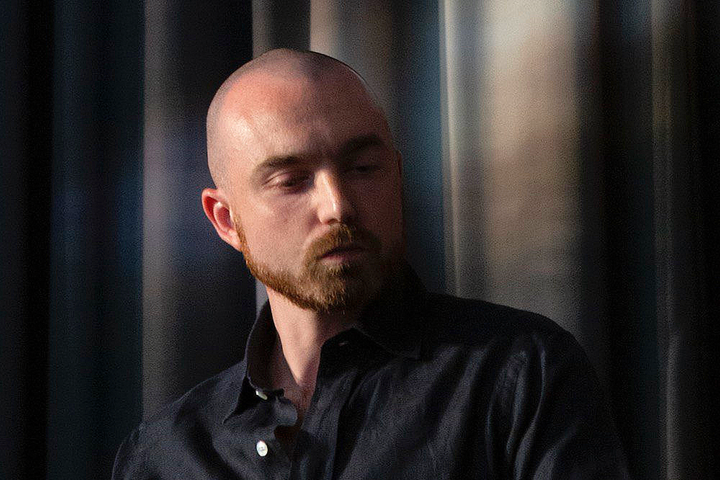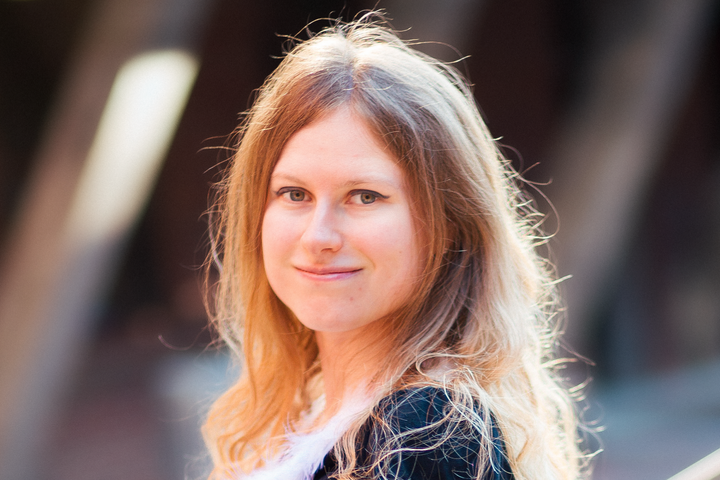Everything Everywhere All At Once

Snejana Krasteva with Merlina Rañi
A Two-Way Q&A Between Stellar Curators as a Panel Conversation that Questions Everything from Museums to So-Called Creators to Trying to Emulate Physical Spaces Virtually (No Bueno) to Utopia, and even Scarcity
Snejana Krasteva, Chief curator at Luminous Art Foundation.
Merlina Rañi (São Paulo, 1987) lives and works in Buenos Aires, Argentina as an independent curator trained in the praxis and self-taught studies that combine esthetic, art theory, philosophy, and scientific divulgation.
Merlina Rañi Question to SK: Besides curating independent projects, I work a little bit with institutions. It’s a very different experience. Regardless of exhibitions showing digital work, I would like to have your opinion on the specificities of institutional curation?
Snejana Krasteva: Of course. I heard you say that a big part of your work in the digital space is making the environment accessible, especially for people who don't know how or who have a bad internet connection. You also mention a very short communication cycle, nearly secretive up to the exhibition date. Well, it’s very different in an institution, we don't rely on internet connection, and the communication–everything really–is much slower, with a lot more long term planning involved, because of shipping, production, and people’s transit. However, I can’t stop thinking about that question of access, which touches not only the question of providing physical access–walking through the doors of the museum–but also interpretation, meaning, and let's say, concept. In this context, the internet connection you mention, can be compared to the experience visitors have in the museum, and sometimes, we miss it, and there is no connection. In this sense, curating, no matter the platform, is about building environments and creating accessibility, not only for the visually and hearing impaired, but for everyone, which has to take into account a certain mindset to assimilate art.
Snejana Krasteva Q to MR; Tell me, you say that it's a very important moment for digital art, and I totally agree. It might be about time that it gets more visibility and legitimacy. But when the NFT hype started, I couldn't help looking for the net artists? Why are they not taking up that space? Why is it mostly populated by so-called creators, mastering tools that they already deal with on a daily basis, but that contemporary artists from more traditional forms don’t have. In this kind of pseudo-democratic space, I find it a little problematic. And also the fact that anyone can be a curator. What do you think about this?
Merlina Rañi: Well, there are a lot of points to be made here. On the one hand, you have a lot of artists or digital artists that do not agree with the NFT circuit, because ideologically some of it contradicts their philosophy. For example, the idea of the single original. In the digital art space you can look at everything being a copy or as having many originals as well as many copies. However, you don’t focus on scarcity. This is big in the current discussion. There is also the issue of the environmental impact. And another point is more material, the NFT circuit is based on platforms with defined formats that fit marketplaces and social media, which in turn limit how you can show art pieces. On top of it, NFTs are ruled by a collection logic, which is also commercial, so if you don’t produce something that resembles a collectible, it limits the type of production that you can show. And you cannot make an art show on a marketplace. Things are changing however, it was more limited in the beginning, today you can create an editorial showcase, like on SuperRare for instance, which allows you to have a curatorial proposition in the virtual space. You can also now make a smart contract outside of a marketplace without the limitations of size, format, or commercial circuit, and ultimately show what you want. But it’s still comparable to the Far West, there are no rules and lots of scams.
On the other hand, as you said, there is the question of everyone being an artist or a creator or having a museum. The thing is, I don't think that everyone knows that art is a convention. So the convention begins to lose its form. It begins to be like a monster. Personally, I like monsters, and I don't think that it's a terrible idea and I don't think that it's forever. We are now in a moment of mutation, and it's messy, but it's also interesting. To be an artist you need to exercise some sensibility, if everyone makes art it won't be the same thing as those who have dedicated their lives to it. The same happens to curation. I'm seeing a lot of curators that don't have any knowledge about digital art and now are working with NFTs on important galleries or platforms. Sometimes it's a little bit frustrating, but the kind of work that someone like this makes and what I do isn’t the same. Not to say that theirs is worse because there is perhaps something interesting in the naive approach. But it's not the same. I try not to worry much about it but I notice that people who hold the art circuits and part of the audience don't make a distinction between an artist that works deeply with digital material from one that takes from it. I can’t even criticize it much because I don't think that art is necessarily better if you put more effort into it. But I do think it's a matter of language, which is a very important point in crypto art because it's mixed with the cultural, entertainment, and design industries. Yet design and art are different. The former usually manipulates language to generally sell something, and the latter, at least the art that I like, has to resist manipulation because it tends to condition people, even artists. One way to determine if something is art or not, is to look at the way that the language is used. Is it there to manipulate to do something or is it attempting to find its own language?
As for curating I don’t think we have to worry, it’s not enough to say that NFTs will change the world–I see that statement sometimes and I think it’s horrible–but it’s about introducing the poetics of the artists, tend to your own investigation, and have something to say about what is happening, sometimes taking the sociological context into account.
Snejana Krasteva Q to MR: From what I've read about your projects, you were one of the first to bridge exhibitions between physical and virtual spaces. Can you say a little bit more about translating from one space to the other? Is it important to marry both? Or should they live their separate lives and that's okay?
Merlina Rañi: I like both spaces very much, so it’s more about the viewer. The virtual is always about simulation and symbolic displacement. When you visit a virtual exhibition, you are performing an experience, while when you visit a physical exhibition, you are experiencing the environment directly. The difference is that the virtual uses an intensive language, while the physical is an extensive language. But then I also think that the digital can be very physical. Even if your body is supposedly on a chair doing nothing, I don't think that there is a difference between the mind and the body. So I like to think in terms of intensive or extensive languages because it has to do with the gesture of the body, but not in a Cartesian Dualism kind of way.
It could be interesting in some cases to mix, for example presenting digital art as an installation. But to show physical works in a virtual context is more difficult. I like digital exhibitions when they are respectful of that environment, I don't like shows that try to recreate a real gallery. For anyone over 30, the virtual environment is uncomfortable, and you don't want to scroll through 50 art pieces there. It's better to use the possibilities of the digital as a support than to emulate a physical place. Net art is already working with internet material, but even if you are not showing an exhibition of Net art, you can perhaps use some of its tools to make an experience that is more accurate for the virtual space. You also need to take into account the notion of time when creating a digital experience, five minutes online can seem like an eternity.
So the question remains, how to differentiate both spaces if we agree they are both physical? Since the virtual is growing its economic structure you start to have more material things, since going through the dematerialisation of art since the ‘60s, it’s very interesting and increasingly difficult to make distinctions between the physical and the virtual, even if you can’t touch them NFTs are art objects, in fact they use real energy when they are minted.
Merlina Rañi Q to SK: There are some institutions that have made NFT exhibitions, such as the ZKM, Center for Art and Media Karlsruhe, in Germany who did the “Crypto Art, It's Not About Money” show, which was an historical perspective of the phenomenon, nearly anthropological, including PFPs not because they consider them art but because they were the first NFTs out there; and then you have institutions from the crypto world such as the Museum of Crypto Art, who have a very different outlook and a very big gap in the way they look at the NFT landscape. If you consider these different types of exhibition making, what would be a good approach to present art from this space?
Snejana Krasteva: That's a good question that I would have to ponder. I should start by saying that I struggle with the term NFT art. I prefer to use NFT-based art, because it's just an instrument. So considering that, some of the best NFT-based art is very conceptual and goes back to how institutions dealt with conceptual art. And that was very hard at the beginning because it was quite dematerialized and unspectacular. So answering the question of how to show this new format, especially if it's not phygital or located on the blockchain or generative or about pixels on the screen, it’s a very similar question to what happened in the ‘60s with the dematerialization of art, which you have already mentioned. So again, it's like facing the problem of how do you deal with conceptual art in an institution, as we are expected to fill the physical space and where the visitors are increasingly expecting some kind of spectacle.
Snejana Krasteva Q to MR: We are constantly trying to find something in art history that relates to the current moment. I am not familiar with the exhibition in Karlsruhe and perhaps I missed something on how they based it conceptually in terms of long or short history but it prompts me to research it further. Tell me again, to which part of history did they go back to?
Merlina Rañi: The history of NFTs. They placed it in 2017 as the “real” beginning. They showed some NFTs from their own collection and some other, including collectibles. They also made a show with pioneers of computer art, artists who work directly on the blockchain, and generative art, which I found more interesting. It is a little controversial because some institutions say that they aren’t making art exhibits. It opens a lot of thinking avenues, while at the same time this space evolves in unpredictable ways. But it also demonstrates that it’s not just a trend or a fashion, which makes it challenging and interesting and I am still thinking about my positioning in relation to it. We are also not just talking about art, but an economic structure that affects everyone and how they position themselves in the world. I am not saying it will ruin the world or something, but I think that it will change a lot of things, because it is already, unless you live off the grid on a farm.
Snejana Krasteva Q to MR: It's interesting the forecast that you are making. In a way, everything starts from an utopian thinking, whether it transforms immediately into economic structures or not. I'm not sure. Maybe some are born with these economic structures like NFTs are. Progress, the ambiguous technological kind, is often economically and military driven. So then this utopian thinking where you would have this decentralized world without monopoly or gatekeepers, with direct access, and where everyone can be part of the minting process is the same utopian thinking that existed when internet was born, where there was this hope that some kind of equality will be achieved and, say, gender could be forgotten. Yet, none of that happened. The same I believe happens in this decentralized system of the blockchain, where in the beginning it was fantastic until the corporations arrived. What do you think?
Merlina Rañi: I agree. But I think that the changes may not be aligned only with utopian thinking but also with other things such as the subjectivity that comes from the possibilities of the Internet. Utopia is suspect because we don't have the experience of it as we imagine it. For me as an art worker from Latin America, I don’t agree with everything in this space but the NFT phenomenon was very good at the beginning, bringing tools and time to make art, when before it was very difficult to have financial support for art projects or for investigating digital or new media art–no one was interested. With crypto it became easier for art workers in the global south, it represented an opportunity, although now it's more messy and difficult again, it has its moments.
On another hand, this so-called free space depends on a very technical alphabet, which is not easy to access if you are not interested in thinking in financial terms every day or maybe you are not good with informatics. To have this sovereignty, you have to be technically and financially savvy. So I think that’s where the utopian idea ends. Having said that, the platforms and the different interfaces are becoming easier to use, but the acces it is not decentralized.
Snejana Krasteva Q to MR: There is this Iranian artist, Behzad Noori, who coined the term Brieftopia, which is a brief utopia. It describes this very short moment before utopia becomes anti utopia but where you can still have the power to change things, as a tool of empowerment. Do you think that NFT-based art is still experiencing this brief utopia or has anti utopia already settled in?
Merlina Rañi: I love the concept of Brieftopia. It's nice because it makes things possible. Perhaps everything is happening at the same time though. And this is the particularity of virtual reality. Even if it's physical, it has the power of simultaneously being different kinds of things. Perhaps it hasn’t ended, just getting more complex every year. But the anti utopia, I think that it's always been there because it has also a very old neoliberal ideology that never proposed equality or democracy and such. It remains a double discourse because it's unresolved. So I think that everything is happening at the same time, this is my answer.



